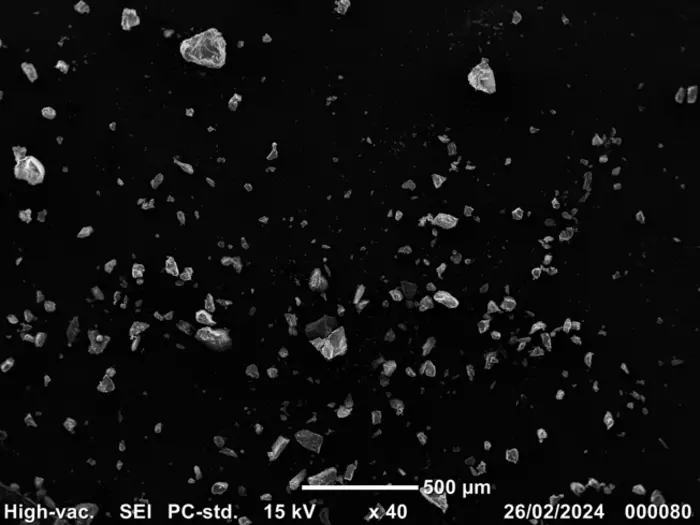As humanity embarks on its ambitious journey to return to the moon through NASA’s Artemis program, a groundbreaking study from the University of Technology, Sydney (UTS) emerges, shedding new light on the impact of lunar dust on human health. Contrary to longstanding fears, researchers have discovered that the dust from the moon presents significantly less risk to human lung cells than previously anticipated. This revelation is particularly timely as it reassures the health considerations for astronauts preparing for lunar exploration after over half a century.
The research, published in the esteemed journal Life Sciences in Space Research, involved rigorous laboratory investigations led by UTS PhD candidate Michaela B. Smith. In her pioneering work, Smith explored the effects of state-of-the-art lunar dust simulants on human lung cells, specifically comparing their impacts against particulate matter gathered from a heavily trafficked street in Sydney. The implications of this study could prove pivotal for the upcoming Artemis missions, which are designed not only for short-term exploration but also to establish a sustainable human presence on the lunar surface.
Michaela B. Smith’s concerns regarding astronauts’ health take root in the experiences of Apollo mission crew members who reported respiratory challenges subsequent to their lunar excursions. Investigating the cellular impacts, Smith’s findings suggest distinct differences between the nature of lunar dust and its Earth-bound counterpart. While the lunar material may act as a nuisance due to its abrasive texture, it does not incite the level of cellular damage or inflammation characteristic of urban dust exposure. Such insights are instrumental in distinguishing between mere physical irritants and those materials that pose genuine health risks.
Smith articulates a noteworthy distinction; lunar dust may induce temporary airway irritation but lacks the potential for chronic diseases that materials like silica dust can cause, such as silicosis—a lung disease associated with long-term inhalation of fine particles in occupational settings. She emphasizes the importance of understanding the immediate versus long-term health effects of these exposures.
Historical accounts from Apollo missions reveal that astronauts experienced exposure to lunar dust primarily during extravehicular activities. When they re-entered their landing modules, fine particles that had settled on spacesuits were disturbed, circulating within the confined environments and leading to respiratory discomfort. Smith clarifies that any inhalation of dust can catalyze sneezing and coughing due to physical irritation, yet emphasizes that lunar regolith does not carry the toxicity associated with materials like silica, which leads to serious health issues over prolonged exposure.
The UTS study specifically focused on fine particulate matter, defined as particles measuring 2.5 micrometres or smaller. Such particles have the capacity to evade the body’s defensive mechanisms and embed themselves within the lower airways. Smith’s research methodically employed various lung cell types, representing both the bronchial and alveolar regions, to observe the differential impact of lunar dust versus urban particulate matter on cellular health.
Remarkably, results indicated that Earth-derived dust provoked a notably more robust inflammatory response and was found to be more detrimental to lung cells than the lunar dust simulants tested. The study posits that the mechanics of toxicity associated with lunar dust primarily stem from its unique physical characteristics—specifically its jagged, irregular shape, which can mechanically disrupt cells upon internalization. Critically, the lunar dust simulants did not elicit significant oxidative stress, a biological pathway commonly linked to particulate toxicity.
These findings lead researchers to conclude that under exposure levels typically found in Earth’s polluted air, the health risks posed by lunar dust are minimal. However, it is paramount to recognize that while research diminishes fears related to lunar dust exposure, NASA continues to take the threat seriously. This is reflected in recent astronaut suit designs aimed at preventing contamination. Smith also reported on innovative engineering strategies at NASA’s Johnson Space Center, where suits are designed to remain outside rovers, thereby eliminating the possibility of fine lunar dust infiltrating the internal cabin environment during re-entry.
While the outcomes of the UTS study provide a layer of confidence regarding potential health risks from lunar dust, it is essential to acknowledge that NASA’s unyielding commitment to astronaut safety encompasses a multifaceted approach to dust exposure risks. As a continuation of her impactful work, Smith is currently directing her PhD research towards understanding how microgravity influences lung function, employing specialized rotational devices to replicate the weightlessness of the International Space Station. This ongoing research aims to explore the cellular integrity and functionalities of lung tissue in an environment where gravity is significantly altered.
Brian Oliver, Smith’s PhD supervisor and a distinguished figure in the field, expresses optimism regarding the implications of this research. He acknowledges that it fortifies the scientific groundwork supporting the safety of human lunar returns while positioning UTS as a pivotal contributor to the burgeoning area of space life sciences—particularly within Australia.
In light of these findings, the study not only addresses concerns regarding lunar dust toxicity but also underscores the broader implications of space exploration on human health. The ongoing commitment to exploring and mitigating potential risks associated with lunar activities further enhances our understanding of the challenges we face in returning to our celestial neighbor safely.
As our aspirations towards lunar colonization and exploration unfold, studies like these will continue to play a critical role in shaping policies, ensuring that the health and safety of astronauts remain at the forefront of such daring endeavors.
Subject of Research: Cells
Article Title: Lunar dust induces minimal pulmonary toxicity compared to Earth dust
News Publication Date: 8-Feb-2025
Web References: DOI link
References: Life Sciences in Space Research
Image Credits: Michaela B. Smith
Keywords
Lunar dust, toxicity, human lung cells, Apollo missions, respiratory health, NASA Artemis program, microgravity, particulate matter, space exploration, health risks.




